Now Restocked: Fruit Trees
We’ve restocked our fruit tree selection for the last time this season! Stop in or shop online to reserve your favorite. Plant now and enjoy beautiful blooms next Spring!
We’ve restocked our fruit tree selection for the last time this season! Stop in or shop online to reserve your favorite. Plant now and enjoy beautiful blooms next Spring!
It’s hard to believe, but the fall season is upon us. Stop in to shop a taste of autumn as we begin to transform the store! Mums, kale, grasses, ornamental peppers and more are now arriving daily.
It’s the time of year when the sight of a rabbit, deer, or chipmunk in the yard can awaken your inner Elmer Fudd. Rabbits and deer nibbling at your leafy annuals and perennials, chipmunks and squirrels munching on your tomatoes – it’s a scene all too common these days…. even in the most urban of yards! Repels All and Rabbit Scram! are our go-to solutions for the weary gardener who feels helpless against the army of critters.

The unique blend of ingredients like putrescent egg solids, cloves, and garlic is offensive to an animals sense of smell without harm! Lasts up to 2 months. When they come in contact, it causes a natural instinct to escape and avoid the area. Available in a concentrate, granules and ready to spray.

is different because Rabbit Scram is more than just another offensive scent or unpleasant taste to foraging rabbits. Blended from selected organic and natural components, Rabbit Scram rabbit repellent is sniffed off the ground by foraging rabbits before they enter your gardens. Rabbit Scram is guaranteed to keep rabbits off your plantings because, through their uncanny sense of smell with their nose on the ground, it convinces rabbits that harm is nearby. As rabbits near the applied barrier of Rabbit Scram, rabbits actually alert to a sense of danger – even death! Rabbit Scram’s unique scent of death reaches the rabbit and triggers a genetic biological defense mechanism to flee from predators. Regular application of Rabbit Scram
rabbit repellent creates a barrier — 24 hours a day! – that rabbits will not cross to reach your plants. And Rabbit Scram’s granular application won’t wash off with rain as many spray repellents do.
Everyone loves the beautiful blue mophead hydrangeas, after all New England has a long and storied history with them – but maybe it’s time to expand your hydrangea horizons. Panicle hydrangeas have wonderfully large, lush pyramidal flowers that provide color and texture for an amazingly long period of time.
Panicle hydrangeas are super easy, reliable, and very hardy. You will be guaranteed flowers each and every summer because the flower buds are formed in late spring on new growth, thereby avoiding the frosts that can damage buds. They adapt to a variety of light levels, from full sun to partial shade and even the shade of a north facing garden.
Panicle hydrangeas offer a very long season of bloom beginning in June and lasting until winter sets in. Say goodbye to that feeling that there is nothing in bloom in the late summer and fall! The cone-shaped flowers are often 12” tall and sometimes taller. Another lovely feature of these hydrangeas is the flower’s ability to subtly change color over its many months of bloom. What begins as a lovely creamy white flower can morph into varying shades of pink, and, with some varieties, even deep pink-red by season’s end. They are shallow-rooted plants that benefit from a 2-3″ layer of compost or mulch. Planted in healthy, organic-rich soil, they require no fertilizer to produce lots of blooms.
They flower true to color so there is no need for soil additives. Pruning is not necessary, especially if you choose a variety whose size is appropriate to your needs. In time, if you wish to contain the plant’s size, you can prune in late winter or very early spring. Come explore the world of panicle hydrangeas. Here are some of our favorite varieties:

Considered one of the smaller paniculatas, ‘Bobo’ grows 3’ tall and 3-4’ wide. But don’t be fooled by its diminutive stature. ‘Bobo’ in full bloom is a spectacular sight. This hydrangea will be absolutely engulfed in large, bright white flowers. It can be hard to see the leaves for all its flowers! The flowers are held upright on strong stems, and continue to grow and lengthen as they bloom. By season’s end, the flowers take on a lovely soft shade of pink.
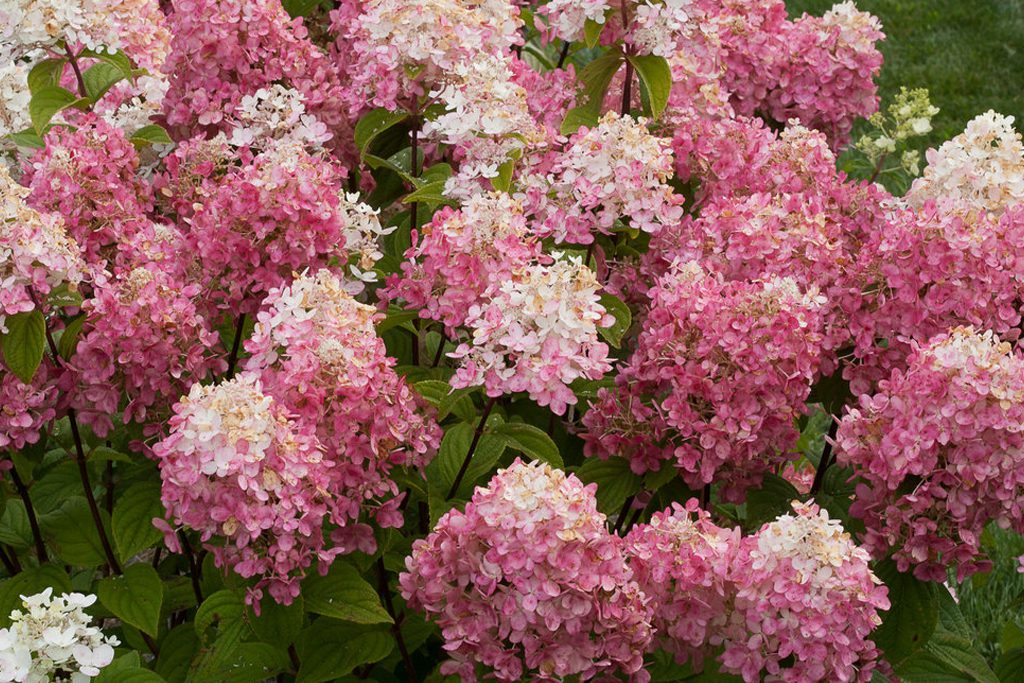
This hydrangea is truly beautiful in a border or foundation planting. Its flowers open a pure white, gradually turn pink, and finish the season a rich pomegranate-red color. The 12-16” flowers are held on thick, sturdy stems. ‘Fire Light’ grows 5-6’ tall.
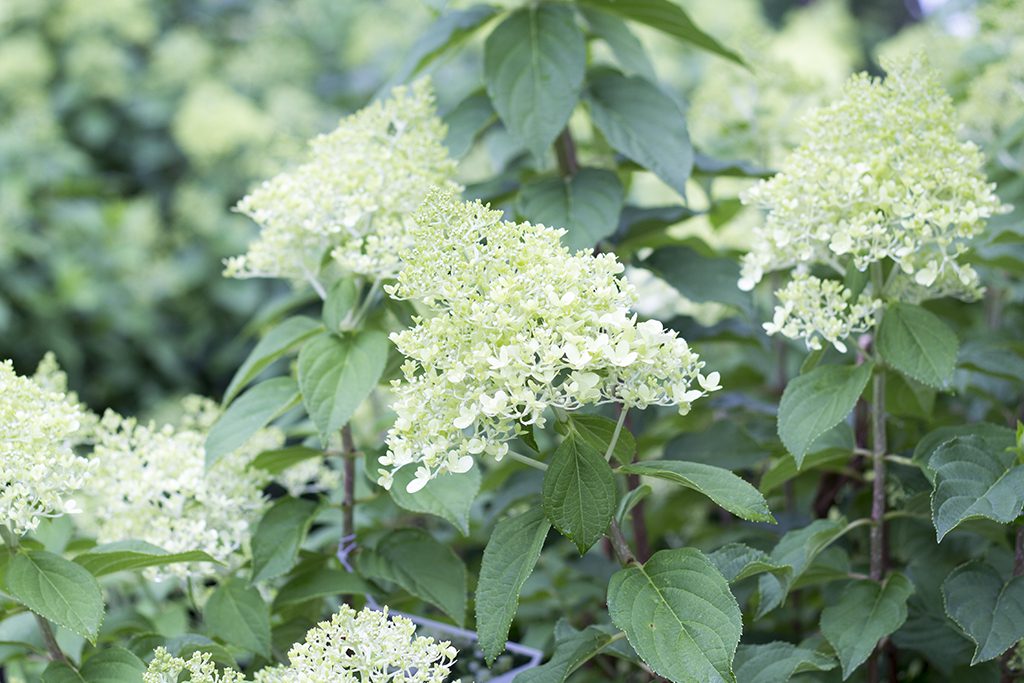
When you see the creamy lime-green flower panicles begin to open, you will understand how ‘Limelight’ got its name. The lime green flowers slowly transform into a soft, antique rose pink over a long season of bloom. The shrub is upright in form and reaches a height of 7-8’. It makes a beautiful specimen plant in the border, and a hedge of ‘Limelight’ lining a driveway is a sight to behold.
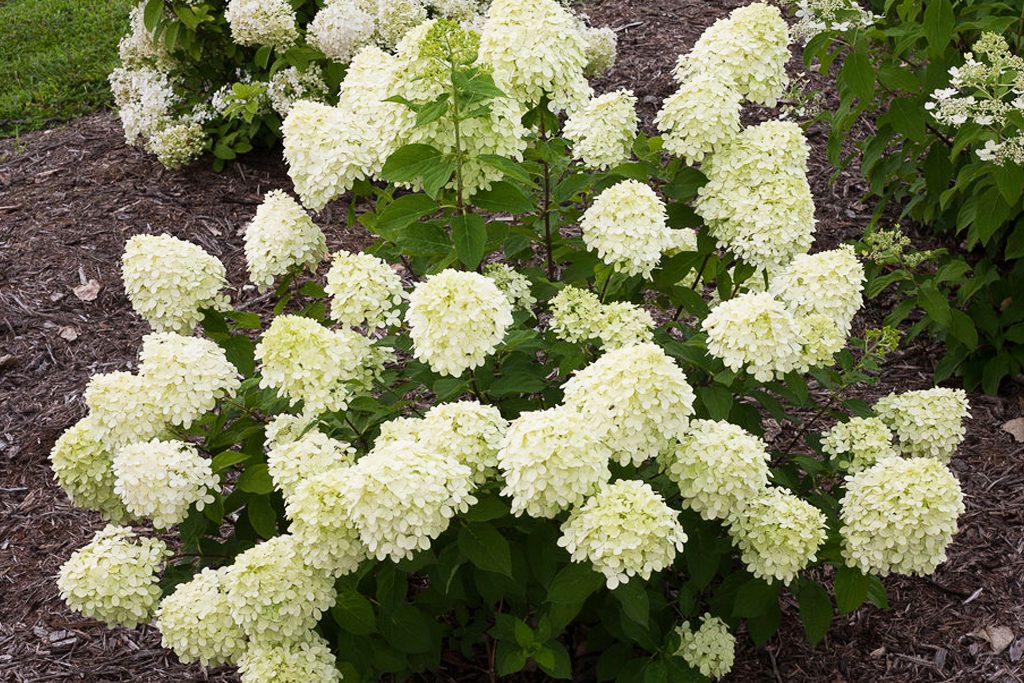
As the name suggests, this is a compact version of ‘Limelight’. It has the same mid-summer creamy lime green flowers on a shrub that grows 3-5’ tall.
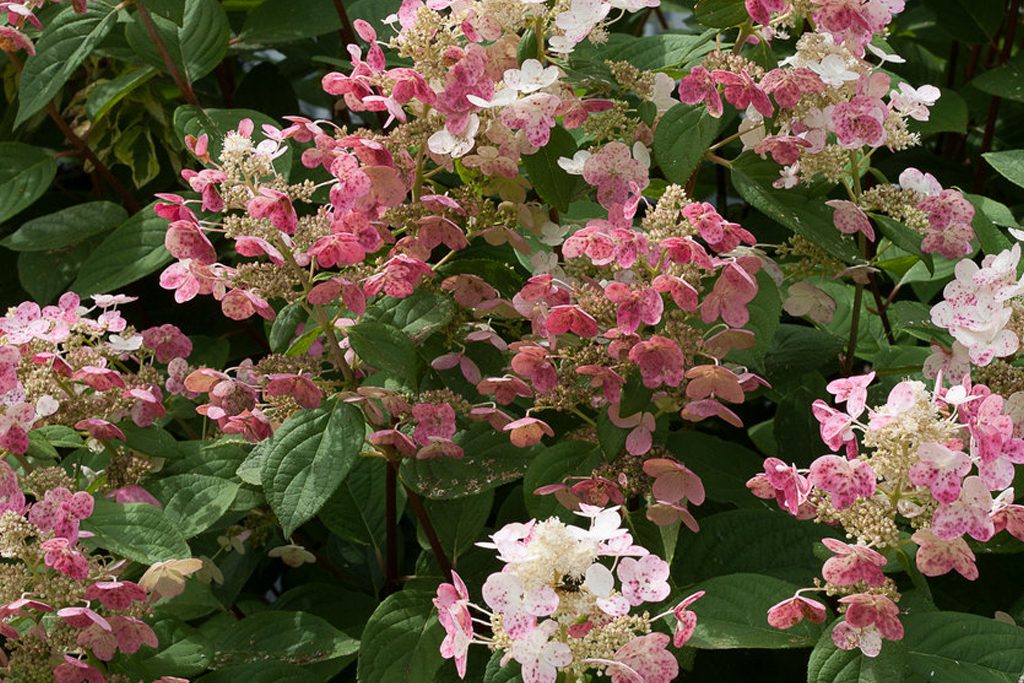
This is the earliest blooming of the panicle hydrangeas, and that is saying something! What begins as a lovely creamy white flower morphs into shades of pink – first soft pink, then medium pink, ending the season in tones of pink-red. Another interesting feature of this panicle hydrangea is its stem color. Red toned stems of summer become mahogany colored in winter, adding a rich texture to the landscape. ‘Quick Fire’ will reach 6-7’ in height.
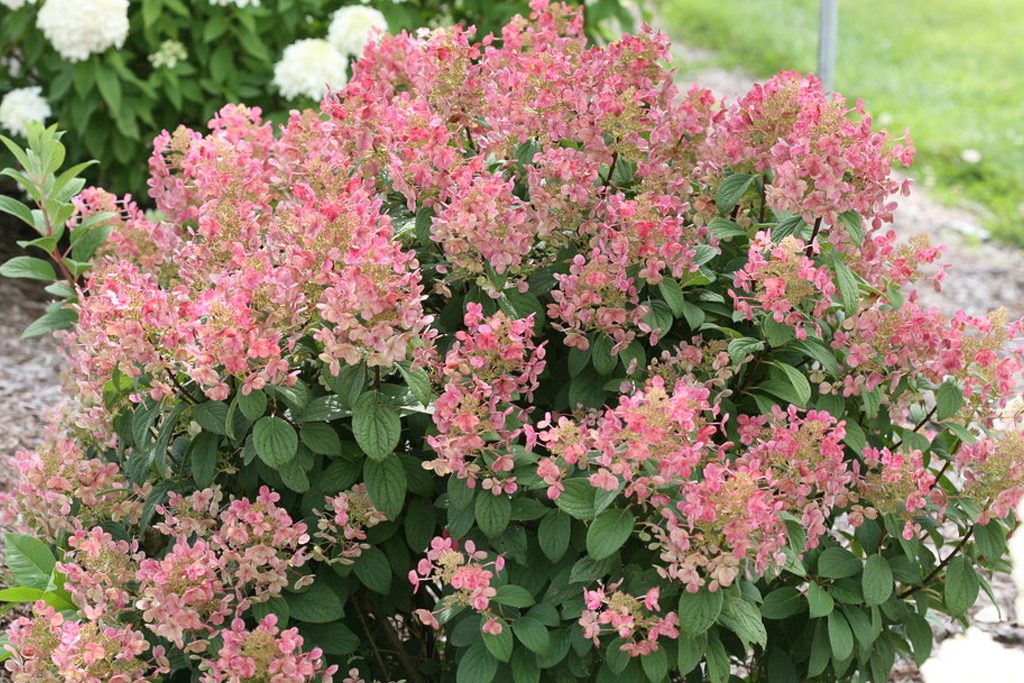
If your landscape can’t accommodate the size of ‘Quick Fire’ but you still want to enjoy its beauty, ‘Little Quick Fire’ is for you. Growing just 3-5’ tall, it has the same early bloom time, exquisite flowers, and great stem color. It’s all there, just in a smaller package.
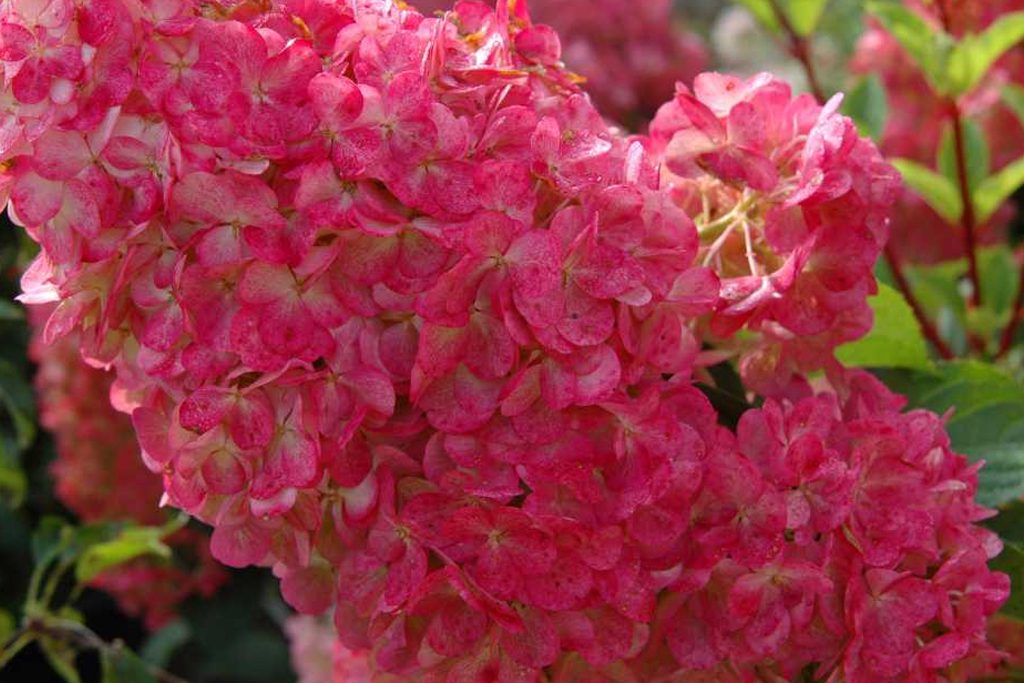
The flowers of this variety begin their colorful journey as pale green before changing to luscious creamy white and then darkening through all stages of pink into rosy-red. New blooms emerge as older blooms change color, giving the plant a multicolored effect. Growing 6-7’ feet tall, the branches will gently arch under the weight of its flowers.
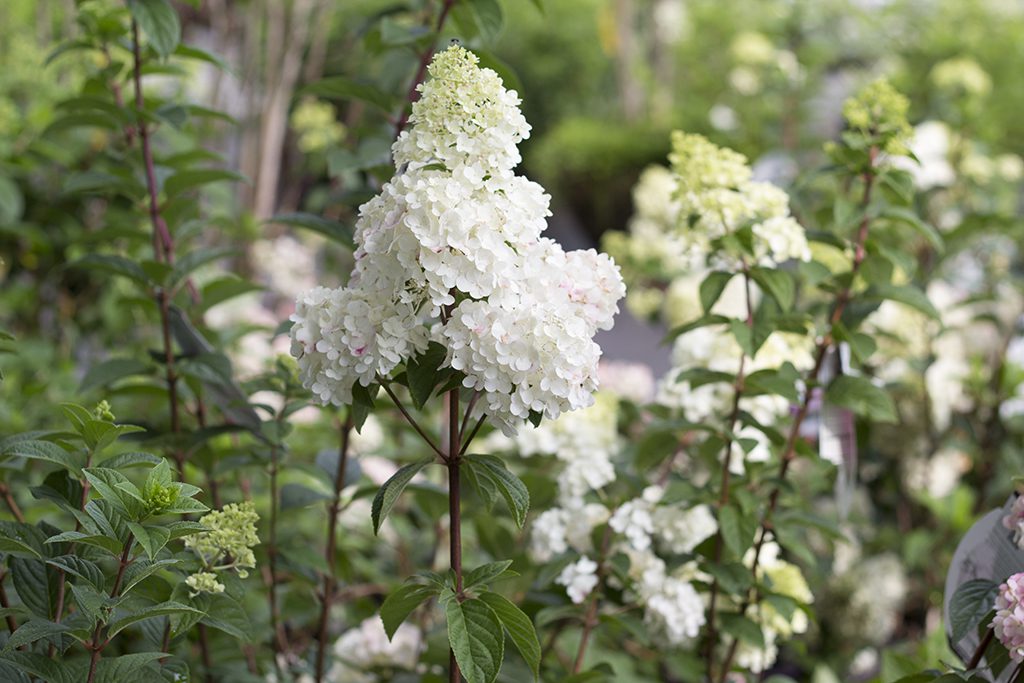
Growing 4-5’ tall and 3-4’ wide, this compact plant is similar to ‘Vanilla Strawberry’. The flowers are numerous and have the same multicolored effect. It brings a sense of excitement to the smaller landscape.
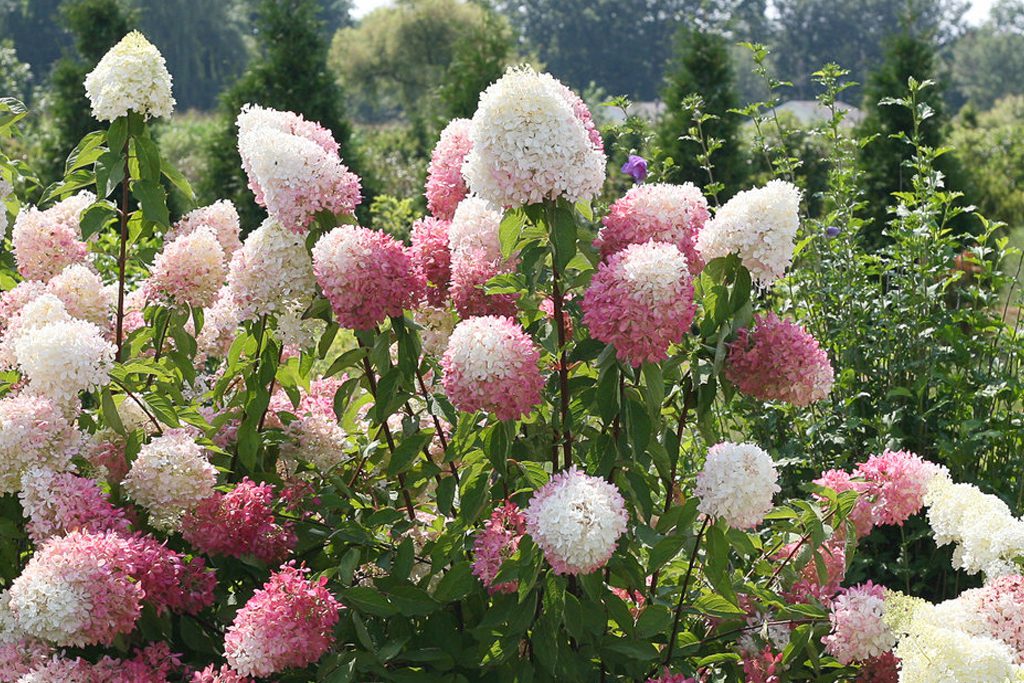
The flowers of this new introduction produce an amazing multi-color display. Its dense panicles of creamy white blossoms blush pink from the base upward and gradually darken to rich raspberry pink. The deep green foliage provides a perfect backdrop for this exuberant floral display. Sturdy, upright stems will grow to a height of 6-8’.
So if you’re looking to expand your hydrangea-horizons, come check out our wonderful stock of panicle hydrangeas! Or, if you have already filled your garden with these wonderful blooms and are looking for upkeep tips, check out our hydrangea care guide here!
Our friend Ben from American Beauties Native Plants visited our Winchester display to highlight some of his favorites from the line! Available at all Mahoney’s stores in honor of pollinator month, it’s the perfect time to plant low-maintenance natives to provide a haven for pollinators. Please note, supplies and selection will vary at each Mahoney’s location.
For masses of color in the garden, nothing beats the Phlox Volcano™ series. Volcano phlox are strong, sturdy and produce an astonishing number of flowers over many summer months. Best of all, these phlox are fragrant and exceptionally tolerant of powdery mildew which plagues other phlox varieties.
Phlox Volcano are tidy, with narrow pointed leaves. Each produces large multi-branched flower clusters, with around 125 softly fragrant flowers per stem. There are many different flower colors – even bicolors – blooming from early summer through to autumn if the old stems are cut back by a quarter after the first flush is finishing.
Phlox are very useful plants in the garden. They look wonderful in massed wedges of color where large areas need to be filled. They are a great way to add pops of color to an existing planting scheme. Mixed with other warm-weather flowering favorites they give form, color and fragrance to containers filled with summer arrangements.
Look out for the following varieties. Please note, supplies and selection will vary at each Mahoney’s location:
We talk a lot about our variety and selection in tomatoes, but did you know Uncle Mike grows a whole collection of cukes too? Here’s what’s growing in our Woburn Growing Greenhouse and shipping weekly to our retail stores! Please note, supplies and selection may vary and this list is not an indication of in-store availability.
—
This All American Selection Winner is a newer variety but most who try it come back for more! Sweet Success is a fantastic slicing cuke with a sweet, bitter-free taste. Yields a bumper crop of seedless, dark green 12-14″ fruits. Very disease resistant!
Days to maturity: 54.
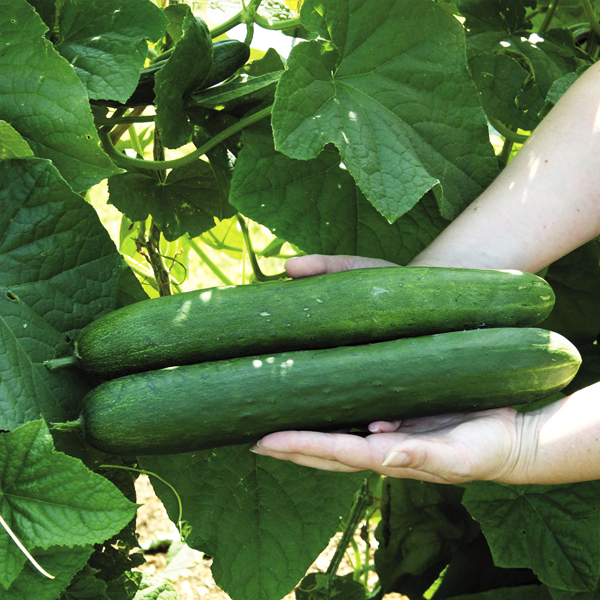
An heirloom variety, and All America Selections winner, Straight 8 is a cucumber superstar. This highly productive and vigorous plant produces cukes with cool, firm flesh and a sparky taste. Pick at 8″ long for best taste!
Days to Maturity: 58.
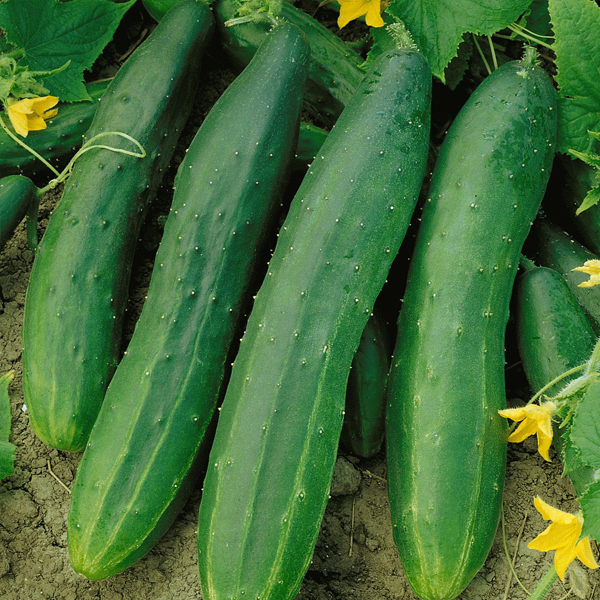
A high-yielding salad or pickling type cucumber on shorter vines – great for a larger container. Crunchy, sweet fruit and non-bitter peel.
Days to Maturity: 50-55.
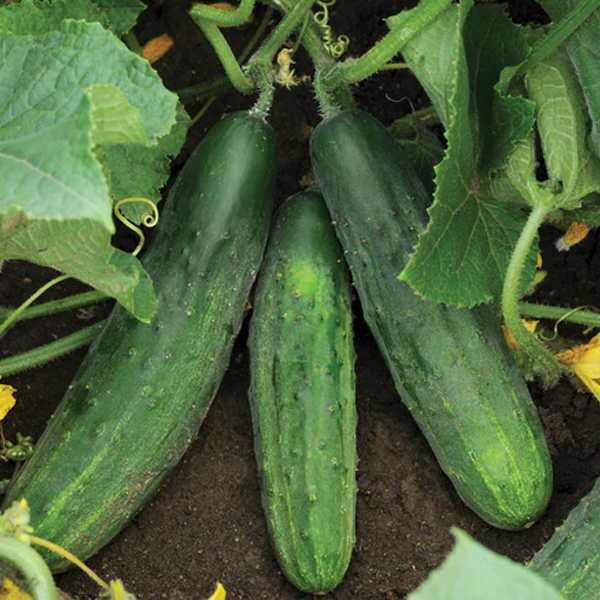
One of our favorites for northern climates, and perhaps the most recognizable heirloom cuke. Dark green skin with impressive fresh taste grows 8-9″ long. Makes for an excellent salad slicer.
Days to Maturity: 70.
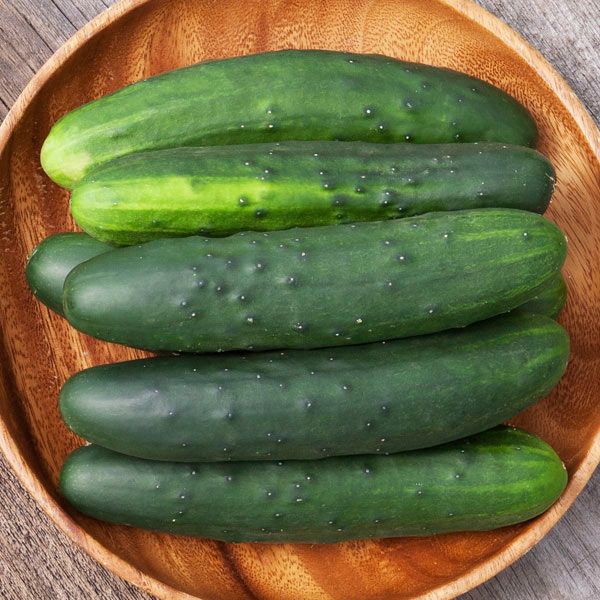
Bred specifically for home pickling, these tasty cucumbers boast solid, crisp flesh and excellent taste. A vigorous, somewhat compact bush type plant that is very disease resistant these can also be used as a salad cuke. Pick anywhere from 1.5″ – 6″ long.
Days to Maturity: 55 days.
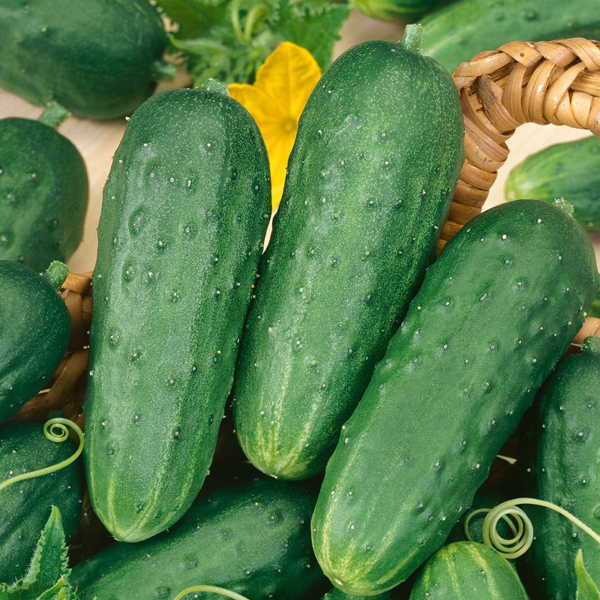
This cucumber contains little to no cucurbitacin, the compound that causes bitterness and indigestion. Known for their tasty, non-astringent flesh this English style cuke reaches 8-12″ long. With very few seeds, Burpless cucumbers are crisp and mild with an easy-to-peel skin.
Days to Maturity: 52.
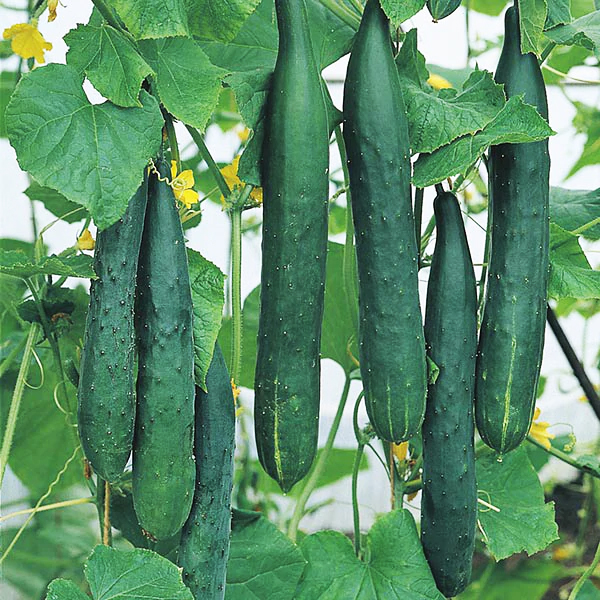
Uncle Mike has a few more favorites grown by our partner farmers that you may also enjoy!
This is a dwarf plant that produces regular salad cukes. It’s great for containers and small spaces and will produce just as prolifically as regular vine type plants!
Another dwarf plant that produces great pickling cukes! This one is also great for containers and small spaces and you’ll get a great yield of cucumbers!
This plant is disease resistant, very quick to mature, and produces a terrific pickling cuke. This is one of the best when it comes to downy mildew resistance, the bane of many a cuke-grower’s season!
This Lebanese salad cuke is not self-fertile and will only produce fruit if pollinated by another cucumber variety. Pick the fruit small for best quality and taste.
It’s a great time to load up on perennial peonies! The Spring favorite is in bud and bloom in our perennial yards now. This season, we’re carrying an incredible selection of varieties to adorn your garden. We have tried and true favorites as well has hard to find varieties, you’ll want to collect them all!
Peonies are garden classics and have been growing in Eastern gardens for 4,000 years. It was used as the Imperial symbol in China and slowly migrated to Japan around the 8th century. Ancient Greek mythology highly regarded the peony for its medicinal purposes, as did the Christians in Europe during the Middle Ages.
Peony derives its name from a Greek myth. Paeon, a student of Aesculapis (God of Medicine), was well aware of the medicinal qualities of peony plants. He used them to heal a wound suffered by the god Pluto which so infuriated Aesculapis he threatened to kill Paeon. Pluto saved Paeons life by turning him into a peony. Another myth replaces Pluto with Zeus.
There are a few myths about peonies and my favorite is about the “nymph” named Paeonia. She was so beautiful that she attracted the attention of Apollo. This did not sit well with Aphrodite, she was so jealous she turned Paeonia into a flower.
There are 3 classifications for peonies, herbaceous, tree and intersectional. All are hardy to zone 3, drought tolerant, deer resistant and low maintenance. There are many varieties to choose from and can be used in the landscape as a specimen, mass planted as a hedge, or in a container on the patio. They do not like to be planted to deep and will last for years with minimal care.
HERBACEOUS – These are the ones that die back to the ground every year. They will grow 3 to 4 feet high and wide and have lush, glossy, green foliage. The flowers come in a range of colors from shades of red, pink, purple and white. Blooms range in size and fullness, from single petal to fully double blooms. Japanese varieties have 1 to 2 layers of petals that surround a cluster of partially formed petals in the center (petaloid stamens). There are many that are fragrant, from a mild scent to a heavy fragrance.
TREE – This variety has a woody stem that stays throughout the winter. Tree peonies can grow 5 feet tall or more but are slow growers. So, it is quite possible your plant will remain small for several years. The flowers are larger than herbaceous peonies and the color range is red, pink, coral, yellow, and purple to bi-colors. Some are fragrant but not as much as herbaceous. They will thrive in dappled shade with only 4 to 5 hours of sun and bloom 2 weeks earlier than herbaceous ones. Although they lose their leaves in winter the woody stems maintain a graceful structure for the season.
INTERSECTIONAL – Also know as ITOH peonies originated by crossing a tree with a herbaceous peony. This was done by Japanese botanist Dr. Tochi Itoh in 1948. Sadly Dr. Itoh died before the seedlings were able to flower. It was up to his family to continue and nurture them until they finally bloomed in 1964. An American botanist, Louis Smirnow, was finally able to get permission to bring some plants to the USA where he patented 4 hybrids and named them ITOH hybrids.
ITOH’S grow up to 3 feet tall and wide. The lush finely divided leaves grow close to the ground giving it an elegant mounded look throughout the season. The have enormous flowers with fluffy petals that surround a cluster of yellow stamens. ITOH’S come in a range of colors including red, apricot, coral, pink and yellow. Just as herbaceous peonies start to fade the ITOH’S burst on to the stage, extending the peony season another 2 to 3 weeks. It is similar to herbaceous as it dies back for the winter and the flowers are large like the tree peonies.
There is a peony for every garden, whether it is used as a specimen, hedge, container or just added to the perennial border. Place fragrant varieties close to home where their scent can be enjoyed. Float a flower in a bowl, cut a bouquet and enjoy these beauties for years to come.
Fill your gardens with bright, long-lasting color. NEW Beacon Impatiens offers high resistance to downy mildew for healthy gardens all season. You can rely on Beacon to thrive. Available in 6 colors, you can fill baskets, window boxes, and shade landscapes with confidence.
Looking for a nutrient-rich bulk soil to fill your veggie garden beds? Introducing our newest product in our bulk lineup: Mahoney’s Ocean Enriched Compost! Watch Patrick explain the benefits of our favorite new item, and you can now shop online for local delivery here: SHOP NOW